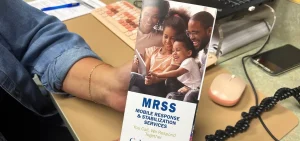News
The MRSS state number for youth in crisis is expanding across Ohio
By: Erin Gottsacker | The Ohio Newsroom
Posted on:
AKRON, Ohio (The Ohio Newsroom) — When Maxx Richards was in sixth grade, they were having a really hard time at school.
“I went to my school counselor for doing self-harm,” they said.

MRSS is a service for people 21 and under experiencing a behavioral health crisis. That could be anything from acting out in class to facing bullies on social media to considering suicide.
Instead of taking a child or young adult to the emergency room or involving the police, caregivers can contact a clinician through MRSS. That clinician then comes to meet the kid in a place they’re comfortable, like their home or school, and help them find ways to stay safe.
Over the past few years, MRSS programs have exploded across Ohio. They’re now available in nearly 60% of the state’s counties, and an investment from the state government means they’ll be expanding further in the months to come.
Calling for help from MRSS
The MRSS call center in Summit County, around Akron, is cozy, decorated with twinkling lights and personalized artwork. Even the ringtone of the phones is gentle — a melody of ascending notes.
Olivia Peer, a clinician, answered when it sounded.
“Summit County MRSS, this is Olivia,” she said. “What’s going on?”
No matter what the answer may be, Peer is ready to respond. Her bag is already packed, and its contents reflect the breadth of what she may be faced with onsite: from medical intake packets and Medicaid referrals to coloring pages and fidget toys.
If a call comes during the workday, caseworkers and clinicians like Peer aim to respond within the hour. But at most, someone would have to wait up to 48 hours for help.
“It’s a lot different than a wait time of a couple of months when you call somewhere else,” said Megan Petruzzi, the director of MRSS in Summit County.
Often, Peer and a case manager take off immediately.
“The ‘mobile response’ is that we come to them,” Petruzzi said. “So we would go to the school, to the home, to the pediatrician’s office, anywhere the family would feel comfortable.”
When the team of two arrives, they tailor their services to the kid; if a child is self-harming like Maxx, for example, they’ll work with them and their family to create a safety plan.
“So we would go into the home and figure out, in the past, what have they used before to self-harm? And we try to restrict those means as much as possible,” Peer explained. “We’ve given families lock boxes before for sharps, anything that could be considered lethal harm. And we also talk a lot about eyesight supervision. How can we keep eyes on this person?”
But MRSS goes beyond the immediate response.
“The stabilization piece is that it’s not just a one time assessment,” Petruzzi said. “We then can offer up to 42 days of services.”
A few times a week, the team follows up with the kid and their family — helping them learn coping strategies, connecting them with doctors for further care and sometimes hooking them up with resources like the food pantry.
For Maxx, the continuous care made a big difference.
“It really helped because people came and they talked to me about how to get through it, explained to me how people want me here and that I am loved,” Maxx said.
An alternative to hospitalization
In the two decades before the COVID-19 pandemic, the number of children and teens hospitalized for their mental health climbed sharply in the U.S. One study showed pediatric emergency room visits for mental health disorders increased 60% between 2007 and 2016 — and visits for deliberate self-harm rose 329%.
Research shows the pandemic exacerbated the problem.
Emergency departments across the country don’t have the space or staff to meet the rising need. And the police aren’t equipped to respond to youth mental health crises either, Petruzzi said.
“There is obviously a time and a place for a police response, just like there’s a time and a place for a youth to go to the hospital,” she said. “But there’s such a high threshold to be arrested. There’s such a high threshold to be admitted to the hospital for a mental health issue that if we can divert to something like MRSS, it’s a faster response.”
It’s a less traumatizing response too.
“We know that going to an emergency department, waiting in a sterile, fluorescent-lit waiting room may not be the most therapeutic environment for a kid who is struggling with a behavioral health crisis,” said LeeAnne Cornyn, the director of Ohio’s Department of Mental Health and Addiction Services.
She says MRSS programs have been extremely successful in Ohio over the past decade.
“Children who receive this service are less likely to be hospitalized, to be incarcerated, and even at a lower cost than an inpatient hospitalization or an initial emergency department visit,” she said.
So Ohio is investing in MRSS. The service is now available in 52 of Ohio’s 88 counties, and the state is in the process of selecting providers for remaining counties.
“The goal is to stand up services statewide in early 2025,” Cornyn said, so that more kids like Maxx can get the help they need.
Maxx is a year older now and says school still isn’t easy.
“Now that I’m in seventh grade, it’s much harder due to the kids,” they said. “I think they’re much meaner now. But my friends are getting me through it.”
Plus, Maxx now has a safety plan and coping mechanisms, and they know the number to call if they need more support.
If you or someone close to you is experiencing a mental or behavioral health crisis, you can reach the state MRSS line at 1-888-418-6777. Or call the crisis line at 988.

